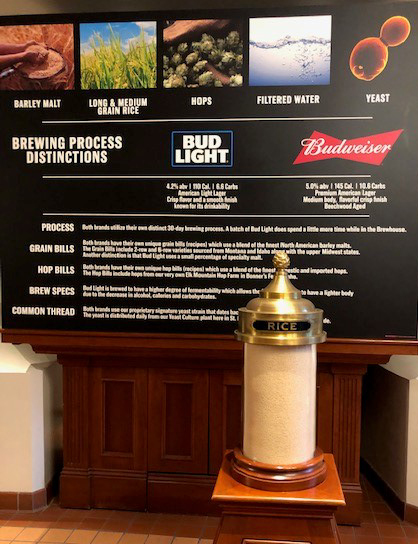 U.S rice is a tour highlight
U.S rice is a tour highlight
Jul 22, 2019
ST LOUIS, MO -- Last week, USA Rice hosted an influencer dinner with nutrition decision makers and foodservice authorities from schools in California, Idaho, and Tennessee at the flagship Anheuser-Busch brewery here. The evening consisted of a VIP tour of the brewery, grain house, and Clydesdale stables with a heavy focus on the role U.S.-grown rice plays in the famous brewery’s operations, and ended in the Schoolhouse Museum where guests were treated to a rice-centric dinner and beer pairing.
“USA Rice hosts this dinner during the School Nutrition Association conference to create new relationships, determine partnership opportunities, build awareness of how U.S.-grown rice helps to meet the new USDA school meals standard, and promote the use of U.S.-grown rice in school meals,” said Cameron Jacobs, USA Rice domestic promotion manager.
Attendees, who represented the Los Angeles Unified School District, Metro Nashville Public Schools, and West Ada School District in Idaho, shared how they incorporate rice in their school districts, challenges they face with serving rice, and how USA Rice can continue to best serve the consumers – their students. All said rice is a staple grain in their kitchens.
“I consider rice the go to grain for schools,” said Chef Brenda Thompson-Wattles from Idaho.
Despite a recent change in regulations for whole grains, brown rice continues to be served across all school districts. In fact, the importance of rice on school menus continues to grow along with the rise in dietary restrictions in the student population.
Dinner conversation turned to the challenge these operators have determining optimal cooking time for brown rice, and their need to better understand the nutritional and culinary differences between brown and white rice. They also were interested in seeing more aromatic rice varieties available for school menus.
“Our attendees represented a combined 792 schools across three distinct regions,” said Jacobs. “Through this direct pipeline to school nutrition officials, we’re able to understand what schools need, whether they’re large or small. We can push U.S.-grown messaging, and position ourselves as the key resource when it comes to questions about rice.”
The biggest take-away from these folks on the front line of consumer research was all about the marketing. How they “sell” rice impacts students’ lunch buying behavior. For example, students are more likely to choose fried rice when it is served in a Chinese takeout container rather than a bowl.
“Hearing ideas like that reiterates the importance of making individual connections with the people on the ground level responsible for menu-planning and school purchasing,” Jacobs concluded. “We owe a big thank you to Anheuser-Busch for helping us put together such a memorable evening.”
The insight and feedback collected at this event will also help shape the format of the USA Rice school nutrition newsletter which is scheduled to launch later this year.